The 1976 Fiat 131, a name synonymous with Italian automotive prowess and rally dominance, marked a pivotal moment in Fiat’s history. This mid-size sedan, designed to compete in the fiercely competitive world of rallying, embodied the spirit of Italian engineering and style.
Its sharp lines, powerful engine, and agile handling made it a formidable competitor on the world stage, earning a reputation for both performance and reliability.
Beyond its motorsport achievements, the 131 represented a shift in Fiat’s approach to car design. It incorporated innovative features and technologies that aimed to cater to a broader audience, pushing the boundaries of what a family sedan could offer. The 1976 model year saw the introduction of several key updates, including a refined engine, enhanced suspension, and a more luxurious interior.
These improvements solidified the 131’s position as a desirable and versatile car for both everyday driving and spirited adventures.
Overview
The Fiat 131 Mirafiori, often simply referred to as the Fiat 131, was a compact car produced by the Italian automaker Fiat from 1974 to 1984. It was a significant model for Fiat, replacing the aging Fiat 124 and establishing itself as a successful contender in the European and international automotive markets.
The 131 aimed to offer a blend of practicality, performance, and affordability, targeting a broad range of buyers seeking a reliable and stylish car.The 1976 model year marked a significant point in the Fiat 131’s journey. While the car’s fundamental design and engineering remained consistent, Fiat introduced several refinements and updates to enhance its appeal and competitiveness.
The Fiat 131’s Place in Automotive History
The Fiat 131’s significance extends beyond its commercial success. It played a pivotal role in Fiat’s history and the broader automotive landscape of the 1970s and 1980s.
- A Successor to a Legacy:The Fiat 131 was designed to succeed the popular Fiat 124, a car that had established Fiat’s reputation for producing reliable and affordable vehicles. The 131 aimed to build upon this legacy while introducing new features and technologies.
- A Global Player:The Fiat 131 was not only successful in Europe but also found a significant market in other parts of the world, including Latin America, Africa, and Australia. This international success helped solidify Fiat’s position as a global automotive player.
- Rallying Success:The Fiat 131’s association with motorsport, particularly its success in rallying, further enhanced its reputation. The 131 Abarth, a high-performance version of the car, dominated the World Rally Championship in the late 1970s, securing two consecutive world championships in 1977 and 1978.
These victories not only boosted sales but also cemented the Fiat 131’s image as a capable and sporty car.
Technical Specifications
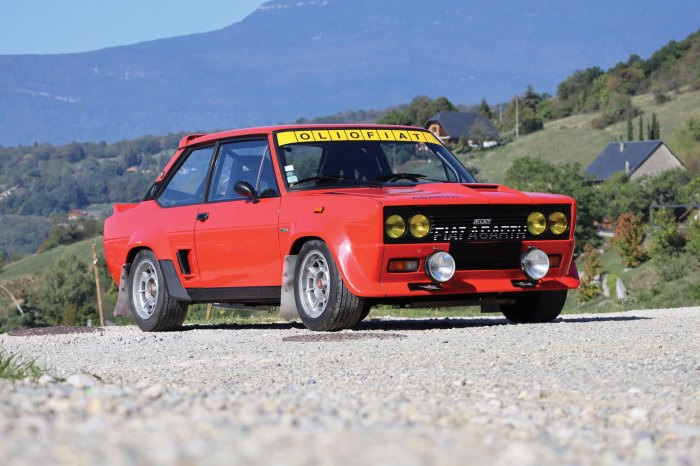
The 1976 Fiat 131 was a technically advanced car for its time, boasting a powerful engine, a robust chassis, and a well-engineered transmission. This section delves into the car’s technical specifications, providing a comprehensive understanding of its engineering prowess.
Engine
The Fiat 131 was powered by a range of four-cylinder petrol engines, each designed to deliver a balance of performance and fuel efficiency. The most popular engine was the 1.3-liter unit, producing 75 horsepower, while the top-of-the-line 1.6-liter engine delivered a respectable 95 horsepower.
These engines were known for their smooth operation and reliable performance, making the Fiat 131 a popular choice for both everyday driving and spirited journeys.
Transmission
The 1976 Fiat 131 was offered with a choice of four-speed manual or five-speed manual transmissions. Both gearboxes were known for their precise shifting and durability, allowing drivers to enjoy the car’s performance potential.
Chassis
The Fiat 131’s chassis was designed for both comfort and handling. The car featured a front-engine, rear-wheel-drive layout, with a MacPherson strut front suspension and a live axle rear suspension. This combination provided a balance of ride comfort and handling agility, making the Fiat 131 a pleasure to drive on a variety of roads.
Performance Characteristics
The 1976 Fiat 131 offered a spirited driving experience, thanks to its responsive engines and well-balanced chassis. The 1.3-liter engine propelled the car to a top speed of around 100 mph, while the 1.6-liter engine could reach a top speed of over 110 mph.
The 1976 Fiat 131 was a sporty and successful rally car, known for its nimble handling and powerful engine. While it might not have the same iconic status as the 1961 Fiat 500 , the 131’s racing pedigree solidified its place in automotive history.
Its performance on the rally circuit, especially in the World Rally Championship, showcased the car’s capabilities and cemented its legacy as a true motorsport legend.
The car’s acceleration was also impressive, with the 1.6-liter model capable of reaching 60 mph in under 10 seconds.
Key Technical Specifications
The following table provides a detailed overview of the 1976 Fiat 131’s key technical specifications:
| Specification | Value |
|---|---|
| Length | 158.7 inches |
| Width | 64.6 inches |
| Height | 53.5 inches |
| Wheelbase | 96.5 inches |
| Curb Weight | 2,100 lbs (1.3-liter) |
| Fuel Consumption | 28 mpg (combined) |
| Front Suspension | MacPherson struts |
| Rear Suspension | Live axle |
Design and Styling
The 1976 Fiat 131 was a car that aimed to blend practicality and sportiness in a design that reflected the automotive trends of the era. It was a significant departure from its predecessor, the Fiat 128, and represented a bold step for Fiat in the compact car segment.
Exterior Design
The 131’s exterior design was a product of its time, showcasing sharp lines and angular shapes that were popular in the 1970s. It was a relatively boxy car, with a long hood and a short rear deck. The front end featured a distinctive grille with a prominent Fiat badge and rectangular headlights.
The side profile was characterized by a straight beltline and a pronounced crease running along the doors, adding a sense of dynamism to the design. The rear end featured a large, sloping rear window and wraparound taillights.
Interior Design
The 131’s interior was designed with functionality in mind, offering a spacious and comfortable cabin for its occupants. The dashboard featured a clean and uncluttered design, with a focus on practicality. The instrument panel was easy to read, and the controls were within easy reach of the driver.
The seats were comfortable and supportive, and the interior was generally well-appointed for its class. The materials used were of good quality, with vinyl and cloth upholstery being the most common.
Overall Aesthetic
The 1976 Fiat 131’s design was a successful blend of practicality and sportiness. Its angular lines and sharp edges gave it a distinctive look that was both modern and appealing. The car’s overall aesthetic was one of functionality and efficiency, but it also had a certain charm and personality.Compared to its contemporaries, the 131 stood out for its unique blend of style and practicality.
It was more angular and modern than the more rounded and conservative designs of its competitors. The 131’s design was also more purposeful and functional, with a focus on efficiency and usability.
Production and Sales
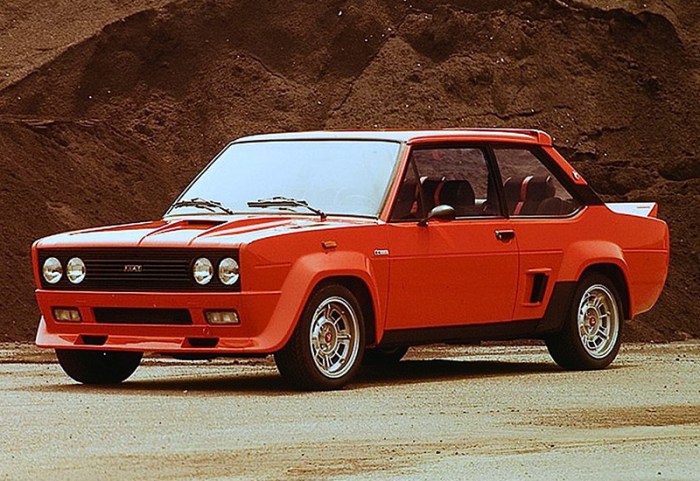
The Fiat 131 Mirafiori, launched in 1974, enjoyed a successful production run that spanned over a decade. This period saw the car evolve through various iterations, with updates and refinements introduced to keep pace with market demands and evolving safety regulations.
Production and Sales Figures
The Fiat 131 Mirafiori was produced in significant numbers throughout its lifespan. Between 1974 and 1985, over 1.7 million units were manufactured, solidifying its place as a popular model in the European market.
- Peak Production:The peak production year was 1978, with over 270,000 units rolling off the assembly lines. This period coincided with the car’s success in rallying, which further boosted its popularity.
- Market Share:In its prime, the Fiat 131 held a significant share of the European compact car market. Its success was attributed to its practical design, fuel efficiency, and competitive pricing.
- Global Sales:While the car was primarily marketed in Europe, it also found a niche in other regions. Notable markets included Latin America, Africa, and Australia, where it was often assembled locally to cater to regional preferences.
Target Audience and Market Positioning
The Fiat 131 Mirafiori was designed to appeal to a broad range of customers, from young families seeking a practical and affordable car to professionals looking for a reliable and comfortable daily driver.
- Family Car:Its spacious interior and practicality made it an attractive choice for families. The car offered a comfortable ride, adequate cargo space, and a range of engine options to suit different needs.
- Value for Money:The Fiat 131 was positioned as a value-for-money proposition, offering a balance of features and performance at a competitive price point. This approach made it a popular choice in markets where affordability was a key consideration.
- Global Appeal:The Fiat 131’s design and engineering catered to diverse markets. Its robust construction and fuel-efficient engines made it suitable for a range of driving conditions, from urban streets to rural roads.
Factors Influencing Success
Several factors contributed to the Fiat 131’s success, particularly in the European market:
- Rallying Success:The car’s participation in the World Rally Championship (WRC) played a significant role in boosting its image and generating positive publicity. The 131’s victories in several championships, including the 1976 and 1977 World Rally Championships, cemented its reputation for performance and reliability.
- Fuel Efficiency:In the 1970s, the global energy crisis highlighted the importance of fuel economy. The Fiat 131, with its range of fuel-efficient engines, became a popular choice for those seeking to minimize their fuel consumption.
- Practicality and Versatility:The car’s spacious interior, comfortable ride, and decent cargo space made it a practical choice for everyday use. Its versatility also appealed to a wide range of customers, from families to professionals.
- Competitive Pricing:The Fiat 131 was priced competitively within its segment, making it an attractive option for budget-conscious buyers. This affordability factor contributed to its strong sales figures.
Motorsport Legacy
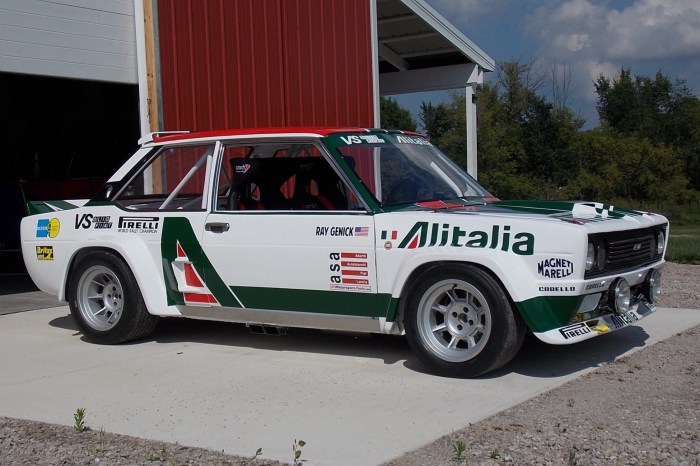
The Fiat 131 Mirafiori was not just a popular family car; it also carved a significant niche for itself in the world of motorsport, particularly in rallying. Its success in this domain cemented its legacy as a formidable competitor and a symbol of Fiat’s engineering prowess.
Rallying Success
The Fiat 131’s journey in rallying began in the early 1970s, and it quickly established itself as a force to be reckoned with. Its lightweight construction, powerful engine, and nimble handling made it an ideal candidate for navigating the challenging terrains of rally stages.
The car’s crowning achievement came in 1976 when it secured the World Rally Championship (WRC) manufacturers’ title. This victory was the culmination of a dominant season, marked by several race wins and podium finishes. The 131’s success was further solidified in 1977 and 1978, when it again claimed the WRC manufacturers’ title, solidifying its position as a true rally champion.
Notable Drivers and Achievements
The Fiat 131 was driven by some of the most skilled rally drivers of its era, each contributing to its legendary status.
- Walter Röhrl: Widely regarded as one of the greatest rally drivers of all time, Röhrl’s partnership with the Fiat 131 yielded numerous victories, including the 1978 Sanremo Rally, where he showcased his exceptional driving skills in challenging conditions. He also won the 1978 RAC Rally, a testament to his ability to adapt to different terrains and weather conditions.
- Markku Alén: Another renowned rally driver, Alén piloted the Fiat 131 to several victories, including the 1978 1000 Lakes Rally, a grueling event known for its fast and demanding stages. He also secured a second-place finish in the 1978 WRC championship, demonstrating the 131’s competitiveness against top rivals.
- Fulvio Bacchelli: An Italian driver known for his consistency and technical prowess, Bacchelli played a crucial role in the 131’s success. He secured several podium finishes and contributed significantly to Fiat’s championship campaigns.
The Fiat 131’s success was not limited to individual drivers. It also achieved notable victories in team events, further showcasing its dominance in rallying. The Lancia team, which ran the Fiat 131, won the 1976, 1977, and 1978 WRC manufacturers’ championships, establishing the car as a true symbol of Italian motorsport prowess.
The 1976 Fiat 131, a rally-bred car known for its performance and handling, was a testament to Fiat’s engineering prowess. While it dominated the World Rally Championship, Fiat also introduced the 1987 Fiat Panda , a compact and affordable city car that appealed to a different segment of the market.
The Panda’s success showcased Fiat’s ability to cater to diverse needs, a strategy that ultimately led to the 131’s replacement with the larger and more luxurious Fiat Croma in 1985.
Legacy and Impact
The Fiat 131’s legacy in rallying extends beyond its championship wins. Its performance and success paved the way for future Fiat models to compete in motorsport, solidifying the brand’s reputation as a force to be reckoned with in the world of rallying.The 131’s impact on the sport is undeniable.
It inspired a generation of rally enthusiasts and contributed significantly to the development of rally cars, setting new benchmarks for performance and technology.
Cultural Impact
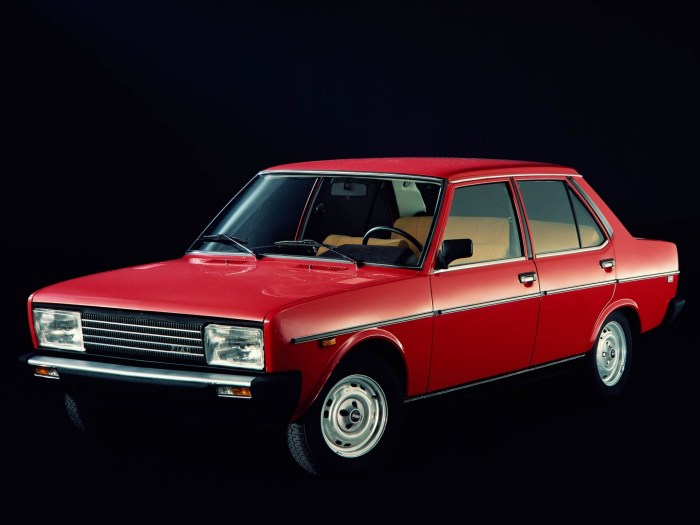
While not reaching the iconic status of some of its contemporaries, the Fiat 131 left a lasting impression on the automotive landscape. It served as a symbol of Italian engineering and design, particularly during the 1970s and 1980s, when it was a popular choice for rally enthusiasts and everyday drivers alike.
Its sporty character and competitive nature resonated with audiences, cementing its place in the hearts of many car lovers.
Portrayal in Media
The Fiat 131’s presence in popular culture is evident in its appearances in films and television shows. While not as prominent as some other classic cars, it has made notable appearances in various productions. For instance, the 1976 Fiat 131 Abarth Rally was featured in the 1981 film “Car Trouble” starring Jack Lemmon, showcasing its sporty and agile nature.
Additionally, the car has been seen in several Italian films and television shows, reflecting its popularity within the country.
The 1976 Fiat 131, a rally-bred legend, was a testament to Italian engineering prowess. Its successor, the 1998 Fiat Barchetta 1998 Fiat Barchetta , took a different approach, focusing on sporty road driving and a more accessible price point. While the Barchetta lacked the rally pedigree of the 131, it captured the spirit of Italian design and driving pleasure, offering a taste of open-top fun for a wider audience.
Enduring Appeal
Despite being discontinued in 1985, the Fiat 131 continues to hold a special place in the hearts of car enthusiasts. Its classic design, sporty handling, and competitive history have made it a sought-after collectible, particularly among rally fans. The car’s enduring appeal is further evidenced by its continued participation in classic car rallies and events around the world, where it often attracts significant attention.
Symbol of an Era
The Fiat 131 serves as a symbol of a specific era in automotive history, representing the golden age of rallying and the rise of Italian car manufacturing. It embodies the spirit of competition and innovation that characterized the 1970s and 1980s, a period when rally racing was at its peak.
Its success in the World Rally Championship, coupled with its popularity as a road car, solidified its status as a symbol of this era.
Legacy and Evolution
The Fiat 131, a compact car launched in 1974, enjoyed a successful lifespan that spanned over a decade. Its evolution reflects the changing automotive landscape of the 1970s and 1980s, marked by fuel efficiency, safety, and technological advancements. The 1976 model year, with its refined styling and mechanical enhancements, cemented the 131’s position as a formidable contender in the European market.
Evolution of the Fiat 131 Model Line
The Fiat 131’s evolution can be traced through various model updates and revisions. Early models were characterized by their sharp styling, with a distinctive front grille and angular headlights. The 1976 model year brought subtle refinements, including a redesigned front grille, new taillights, and improved interior trim.
Subsequent model years saw the introduction of new engine options, increased safety features, and minor styling updates.
- 1974-1976:The initial production run of the Fiat 131 featured a range of four-cylinder engines, with the 1.3-liter and 1.6-liter units being the most popular. This era focused on establishing the car’s presence in the market and refining its core design.
- 1977-1981:This period witnessed the introduction of a 1.9-liter diesel engine, catering to growing fuel economy concerns. The 131 also received an updated dashboard and interior features, enhancing its comfort and functionality.
- 1982-1984:The final years of the Fiat 131’s production saw the introduction of a more powerful 1.6-liter engine with a fuel-injected variant. The car’s styling received a minor facelift, with a redesigned front grille and bumper.
The 1976 Model Year in Context
The 1976 Fiat 131, with its refined styling and enhanced features, solidified its position as a competitive contender in the European market. This model year represented a significant step forward in the car’s development, incorporating customer feedback and technological advancements.
The 1976 Fiat 131 benefited from the evolving automotive landscape, particularly the growing demand for fuel-efficient and reliable vehicles.
Impact on Subsequent Fiat Models
The Fiat 131’s success paved the way for subsequent Fiat models. The car’s innovative features, such as its front-wheel drive layout and its efficient engine options, influenced the development of later models like the Fiat Ritmo and the Fiat Uno.
The 131’s motorsport legacy, particularly its success in the World Rally Championship, also contributed to Fiat’s image as a performance-oriented automaker.
Impact on the Automotive Industry, 1976 Fiat 131
The Fiat 131’s impact on the automotive industry can be seen in its influence on the design and development of compact cars. Its focus on fuel efficiency, safety, and practicality set a trend that would be followed by other manufacturers.
The 131’s success in motorsport also highlighted the importance of performance and handling in the compact car segment.
Epilogue: 1976 Fiat 131
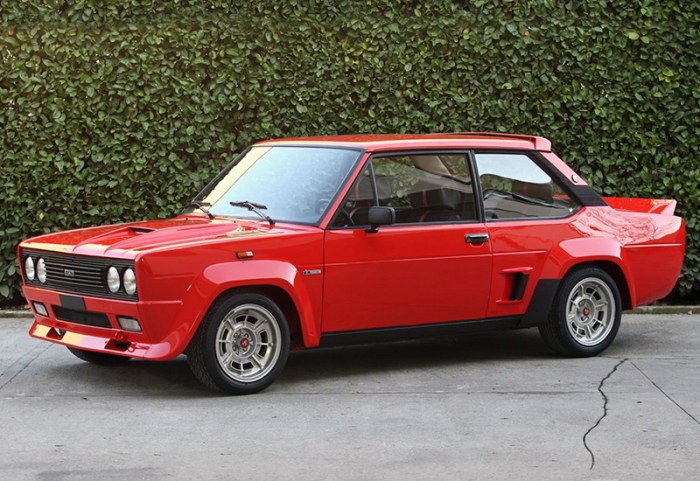
The 1976 Fiat 131 stands as a testament to the Italian automaker’s legacy of innovation and performance. Its impact on the world of rallying, its influence on car design, and its enduring appeal to enthusiasts make it a true icon of the 1970s.
Whether you’re a seasoned car aficionado or simply appreciate a well-crafted piece of automotive history, the 1976 Fiat 131 offers a captivating glimpse into a bygone era of automotive excellence.